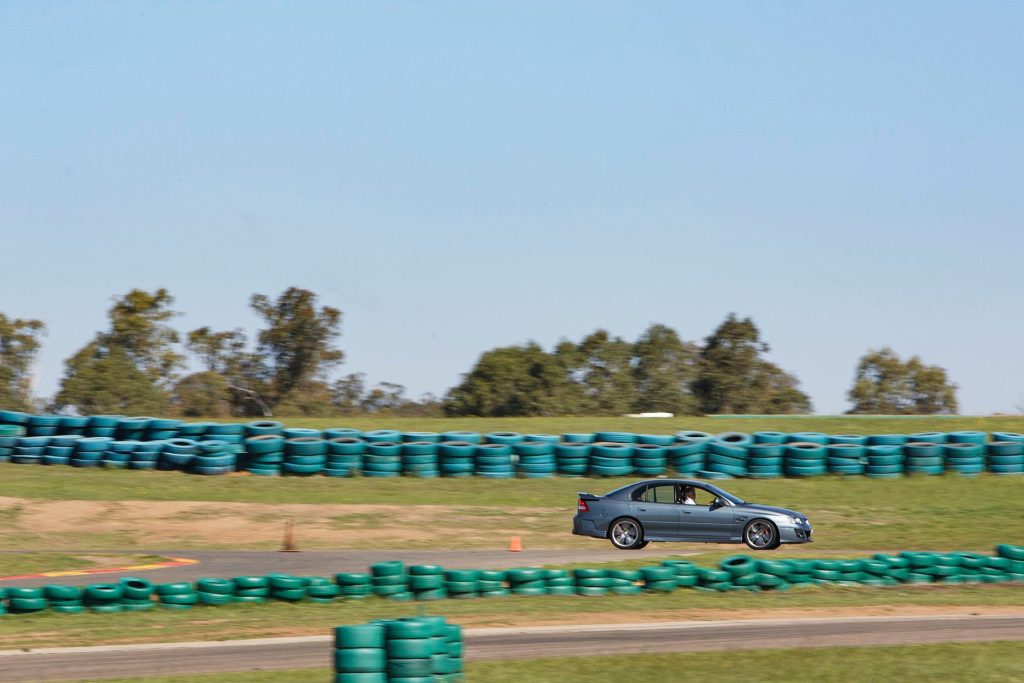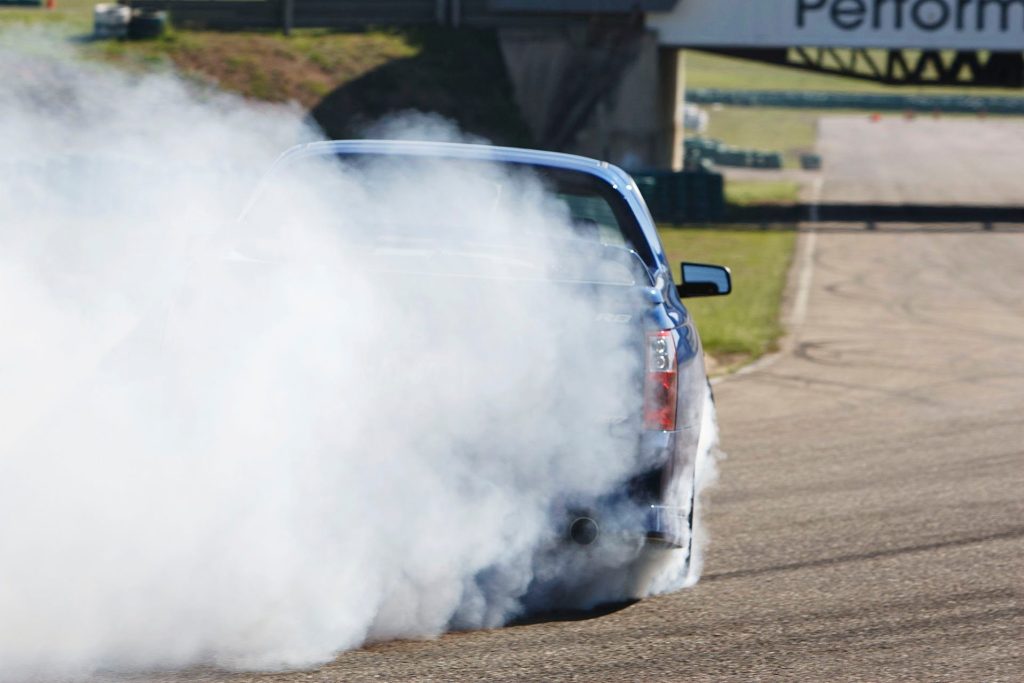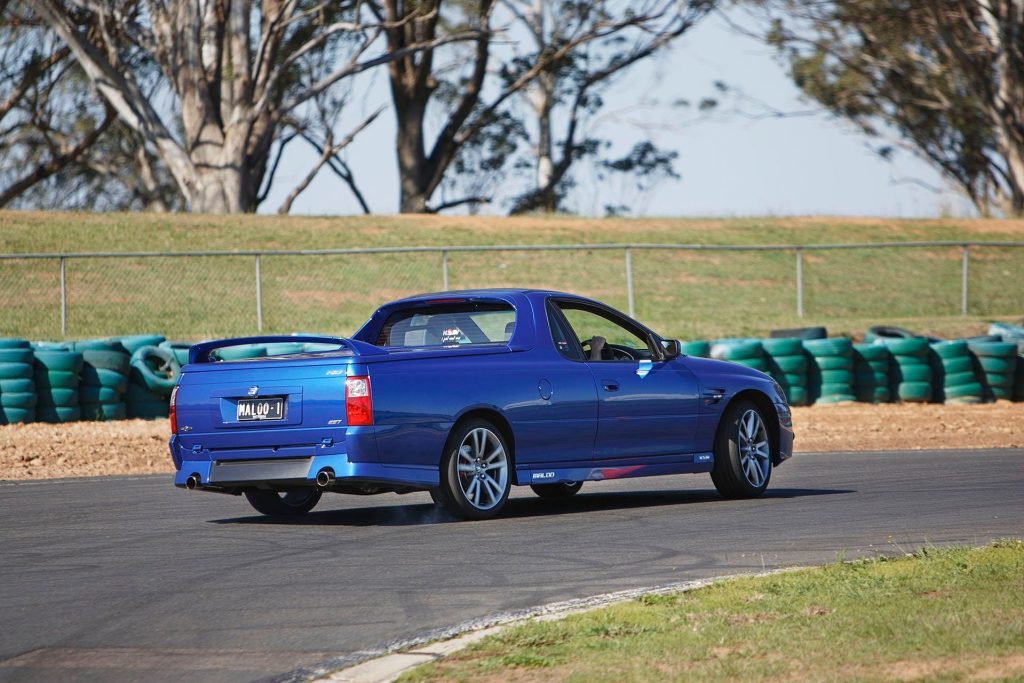2004 HSV VZ range track test
Words: Mark Petch | Photos: Tom Gasnier
They say there’s no substitute for cubic capacity; they also say there’s no substitute for the real thing. We put the Lion’s new 6.0 litre pride to the acid test.
If diamonds are a girl’s best friend, what’s six litres and 300 kilowatts of hairy-arsed V8 to a boy from Bondi? HSV believes it now has the ‘real deal’, a true gem of a car that offers more cee-cees per dollar spent than any other in the world.
After my first few laps around the eastern club circuit of Sydney’s Oran Park motorsport complex, I reckon the boy from Bondi and the sheila with the big rock would also agree “She’s a ripper, mate.” I never got to drive the Maloo ute; I was having so much fun hammering the crap out of the regular HSVs – the Clubsport, GTO, Senator, the twin-nostrilled GTO Coupe and even the luxo Grange – that I ran out of time. But I did witness Greg Murphy’s lurid, tyre-smoking power slides in the Maloo, which frightened the hell out of another Kiwi motor-noter – and this in the week preceding Murph’s fourth big win at the mountain!

Because you take the time to read my ramblings, I assume you’re a car nut like me, so you’ve probably succumbed to reading reviews in other car mags of the new LS2-engined VZ range from HSV. But here’s the dinkum truth: as I write this, it’s the middle of October, and no motoring writer has yet driven the new VZ HSVs on the open road; till now, all media test drives have been either at Holden’s Lang Lang proving grounds, or Oran Park. So none of us can rightly say what the new product feels like when hacking around the city, or blasting down country, us included.
That said, I can tell you that belting around the club circuit was like seventh heaven. I was as happy as a pig in shite, as the Australians have it – a state that makes it hard to be objective about the merits of any vehicle. It’s like gazing into the eyes of the woman you love on a deserted beach – and then trying to meet a looming deadline. And no, I’m not a Bondi boy – and I’m certainly not the boy I once was – but I do subscribe to the view that ‘you can make a man out of a boy, but you can’t take the boy out of the man’. So, your honour, if that makes me a hairy-arsed hoon on occasion, blame my genes.
Do not mistake my enthusiasm for these HSVs for simple brand allegiance either. I am neither a dyed-in-the-wool Holden man nor a Ford freak. I have owned and raced Fords, and still own the famous Jack Mousche IMSA Merkeur, and the ‘Peanut Slab Sierra’, and won’t part with either of them; I also own a C5 TransAm Corvette and a VY Holden NZ V8 Touring car. Which makes me one of two things: agnostic, or a complete car fanatic.

What HSV has done here is to utilise an uprated 6.0 litre version of its outgoing 5.7 litre engine – also recently launched in the new “2005” C6 Corvette – nothing special in itself. In truth, it’s pretty darn easy to slot a bigger capacity engine into most V8-engined vehicles, especially when it’s the same physical size as the one you’re hoisting out. The trick is not to end up with more weight sitting over the wheels responsible for steering the car, assuming the configuration is engine at the front and rear-wheel drive.
It’s a lesson that obviously went out the window with the V8-engined BA down the road at Ford. Regular readers know that I’m inclined to rabbit on about weight over the front wheels, lousy steering and invasive stability control, to name but a few of my pet hobby horses. I have a tough time liking the Boss-engined BA Falcon V8s because of my views about vehicle design and dynamics. Contrast Ford’s 5.4 litre cast iron-based V8 and the current generation of 5.7 litre aluminium-based V8 Holden Commodores, which carry significantly less weight over the front wheels, and you’ll see why I prefer the latter.
However, it’s not all bad news for Ford’s BA Falcon, because there are areas of the BA that are better than the equivalent in the Commodore, such as its rear suspension, ride quality, etc. To make an informed buying decision about which vehicle is right for you, you will need to decide what personality you want in your car: cruiser, or bruiser? Whilst I wouldn’t own a BA Falcon V8, I would happily own an XR6 turbo or, better still, one of FPV’s new Typhoon Falcons, because the Typhoon’s turbocharged twin-cam inline six has even more midrange grunt than HSV’s LS2 Corvette engine.

The trend to ever-more grunt can be seen at the top end of the latest offerings from German car companies as well. Strong engine torque is also the reason the Europeans are buying turbodiesels in droves. And you thought it was because they are more economical, right? Well that’s what you tell the missus.
Torque is what the new LS2 engine has in spades, but it also has an equally addictive, oh-so-naughty V8 bellow that gives you sweaty palms just thinking about the fun you’re going to have when you mash the throttle. That throttle is now attached to HSV’s king hit: an engine designed to shake the faith of even the most loyal V8 Falcon fan. The LS2 V8 develops 297kW of peak power – or 305kW as per Ford’s use of the DIN measurement standard versus the SAE standard of General Motors (and BMW, Mercedes and Porsche, etc.). But, as with the departing 300kW Gen 2 (LS1) engine in the GTS Coupe, it’s not merely kilowatts of peak power that matter: it’s low- to mid-range torque that sets the tongues wagging – just about as fast as a rear end of a new HSV with the traction control switched off. The LS2 produces 530Nm of peak torque at 4400rpm and reaches its maximum power of 297kW (305kW DIN) at 6000. However, the real feel-good factor of the LS2 is its sheer spread of torque. HSV claims 87 per cent of peak torque (463Nm) is available from 1600rpm and the torque curve does not taper off until 6000rpm. Compare this with the outgoing 5.7 litre engine in regular HSV form, which only started to boogie at 4000rpm.
As soon as you put your foot down, it’s obvious that what the LS2 delivers is far greater than the physical difference between the old and the new engines. HSV may call the LS2 engine all-new; I call it PR spin. Both motors share the same alloy block but the cast-iron cylinder liners are now bored out to 101.6mm in the LS2 from the LS1’s 99mm. The larger cylinder bores, in conjunction with retention of the same 92.0mm stroke dimensions, equates to 5967cc, or 6.0 litres in marketing-speak. The compression ratio goes from 10.0:1 to 10.9:1, which also helps explain the more ribald torque delivery of the new LS2 engine. The high compression ratio also means that if you want to corral all your ponies at once, you have to feed them 98 per cent ‘proof’, otherwise they ain’t gunna run at full speed. Thanks to sophisticated knock sensors, you’ll do no harm to the engine on a diet of 91 octane. However, it won’t gallop quite as hard either.

The LS2 cylinder heads are carryover from the previous high-performance Z06 Corvette engine, and feature raised intake ports and better combustion-chamber design. The use of lighter-weight, flat-top pistons results in less reciprocating mass, so the engine will pick the throttle up faster. The flat-top pistons also produce better flame propagation, which allows the use of a higher compression ratio without the same propensity to detonate. It’s not rocket science, as any good ol’ boy will tell you, but there’s life left yet in the simple formula of two big valves activated by pushrods. FPV, Ford’s Performance Vehicles division, is about to discover this in the market place over the next few months. To quote Smoky Yunick of Popular Mechanics: “A boat anchor is still a boat anchor, whether it’s got four-valve technology or not, and ain’t that the simple truth.”
What’s a big thumper without a good box, you might rightly be thinking, given HSV’s history of delivering awful gear changes. The good news is that the new VZ’s finally sport a decent-shifting, triple-syncro gearbox that’s a joy to use. FPV’s new Typhoon also gets the same new six-speed Tremec M12 transmission, as fitted to the latest Corvette. Strangely, it’s the up-rated, heavy-duty, four-speed HMD automatic transmission that provides the quickest 0-100km/h sprint time, at least according to HSV. All the six-speed manual HSV models are claimed to cut the 0-100km/h sprint in an impressive 5.2 seconds and the four-speed automatic in 5.1s. The 0.1s difference must surely be due to the faster gearchange of the automatic transmission, despite the torque converter being far less efficient than a clutch.
My guess is that the new LS2 6.0 litre engine is going to provide HSV with an almost unbeatable package. The pick of the bunch for me is the R8 with the optional AP six-pot calipers – superb stoppies, great pedal feel. A little more laid back than the R8, but still a king-hitter, is the new VZ Senator. Prices are expected to rise only slightly, which is also good news considering that features like 19” wheels and C6 twin-piston brake calipers are now standard fare across the range. If you are a keen club racer – and many HSV club members are just that – then you will be pleased to know that Ohlins adjustable suspension, formerly only available on the GTS Coupe, is now an optional extra on the Clubsport, R8 and GTO Coupe, as are AP six-pot calipers.

After driving all the new VZ HSV’s except the Maloo Ute (see sidebar below), we can’t wait to test the new models in the real world. Almost everything I slammed mercilessly around Oran Park was extremely impressive, with the exception of the luxo Grange. The latter was absolutely out of its depth on the track – the automatic transmission was found wanting up against the new six-speed manual gearbox – but both are probably a good drive between Auckland and Wellington. Nonetheless, the automatic transmission will probably outsell the six-speed manual gearbox by 3 to 1.
HSV says that the bigger six litre engine delivers up to seven per cent better economy, but in fact it’s the taller 3.46:1 final drive ratio that will be chiefly responsible for better gas mileage. The engine’s a dream to drive off slow corners in one, or even two gears taller than is possible with the LS1 engine, and it just loves to rev right round the clock to its 6500rpm redline, thanks to its oversquare bore to stroke ratio.
When you look at HSV’s new line-up objectively, it has to be a real cause for concern for Ford’s FPV division, which only can offer the new Typhoon to fight back. Quite what FPV will do in the future remains to be seen as most V8 lovers would never settle for a six-cylinder engine, and especially a turbocharged version – this despite the fact that the Typhoon blows their own 290 Boss V8 into the weeds. Winning the Australian V8 Supercar championship for a second time, as looks likely, will no doubt be a real image-booster for the Blue Oval. However, the salesman on the Ford showroom floor can hardly tell you that the BA V8, because it has overhead cams and four valves, is superior to the Commodore pushrod engine, when Marcos Ambrose’s Falcon (and all his competitors’) has a 5.0 litre similarly pushrod-operated, two-valve engine, can he? Just let him try but it doesn’t cut it with me, No Siree. Two-valve aluminium-based engines are just dandy as far as this hairy-arsed hoon is concerned.

Made-over Maloo
For all the extra power and torque, HSV’s Maloo has to walk on the wild side no more. Now armed with traction control, 19-inch wheels and the more sophisticated control-link rear suspension, HSV’s second-biggest seller has the ability to be mild as well as wild. What drove this makeover of the ute, which in some ways is more significant than any other model in the range? Marketing, that’s what.
The boys responsible for the image making wanted 19-inch wheels under Maloo’s guards and that’s what engineering had to deliver. The problem was the old dual trailing-arm set-up wasn’t up to the job, allowing too much toe change, which meant the tyres rubbing on the inner guards. The solution? Adapt the control link introduced to the sedans at VX time, and problem solved; it gives more precise control of the rear-wheel toe change on full bump travel. Maloo is now unique amongst Holden’s locally manufactured utes in having this multilink set-up. Using the new suspension design also enabled HSV to employ adaptive traction control on Maloo for the first time, although it was a challenging job because there was no Holden technology to learn from, as the standard utes don’t use it.
Along with the necessary wiring changes, HSV made considerable unique modifications to the ABS brake lines to allow speed detection information to be fed back to the ABS module that forms part of the TC system.

All the work was worth it though. With TC on, the Maloo is a predictable, exciting and very fast drive. TC off, and it’s still a predictable, exciting and very fast drive. But TC off also allows you to experiment a whole lot more with slip angles. Those big tyres and new suspension make power-on oversteer a controllable joy rather than a nervous expectation. The TC is also more subtle in its interventions and, thankfully, the thudding pedal has been consigned to the bin.
Safer, faster, better. Who could argue with that?
And if all that’s not enough, there’s always the R8 version, the main mechanical benefit being the option of those massive AP racing brakes. We can tell you that they really work! Bruce Newton
| Model | HSV Clubsport VZ |
| Price | $TBC |
| Engine | 5967cc, V8, EFI, 297kW/530Nm |
| Drivetrain | 6 speed-manual, RWD |
| Weight | 1667kg |
This article originally appeared in the November 2004 issue of NZ Autocar Magazine.












